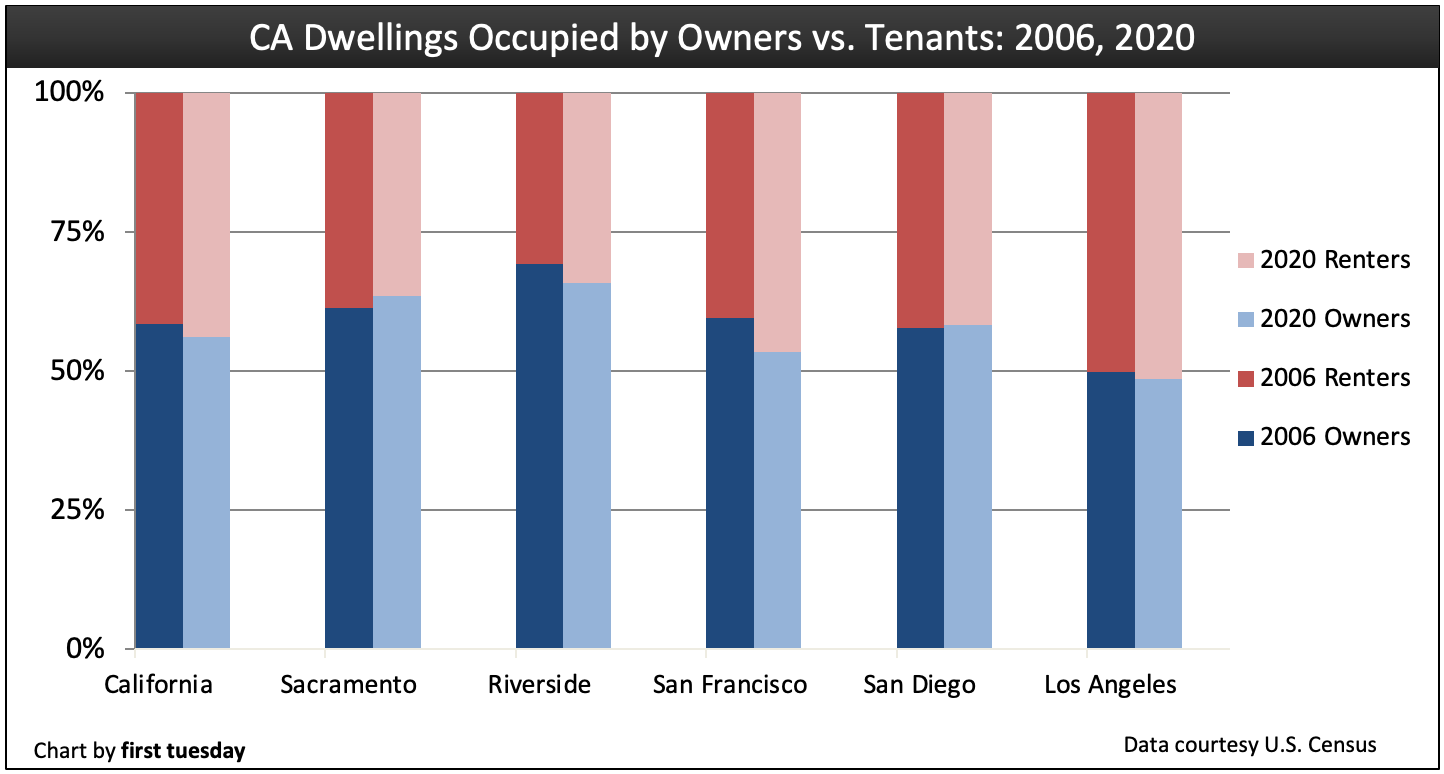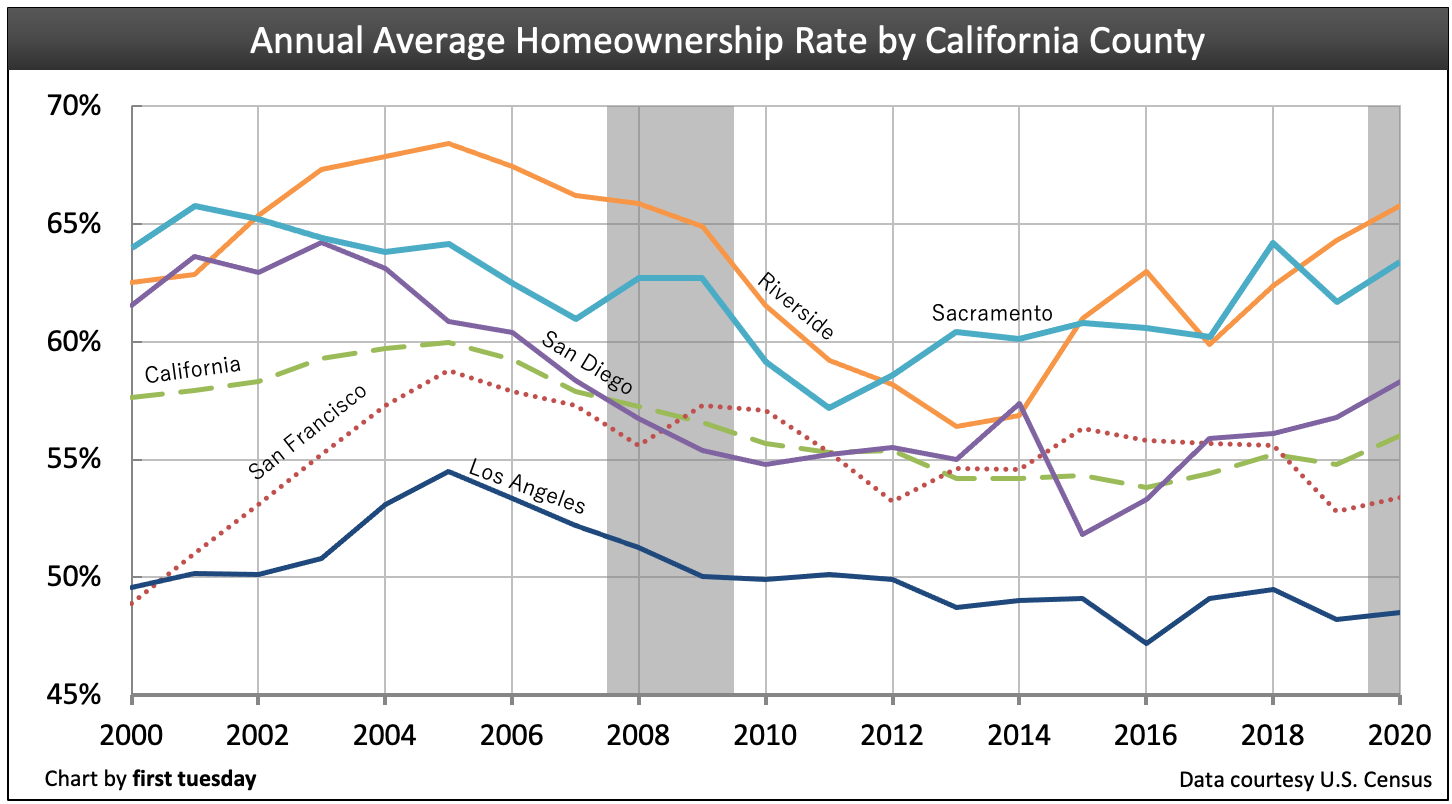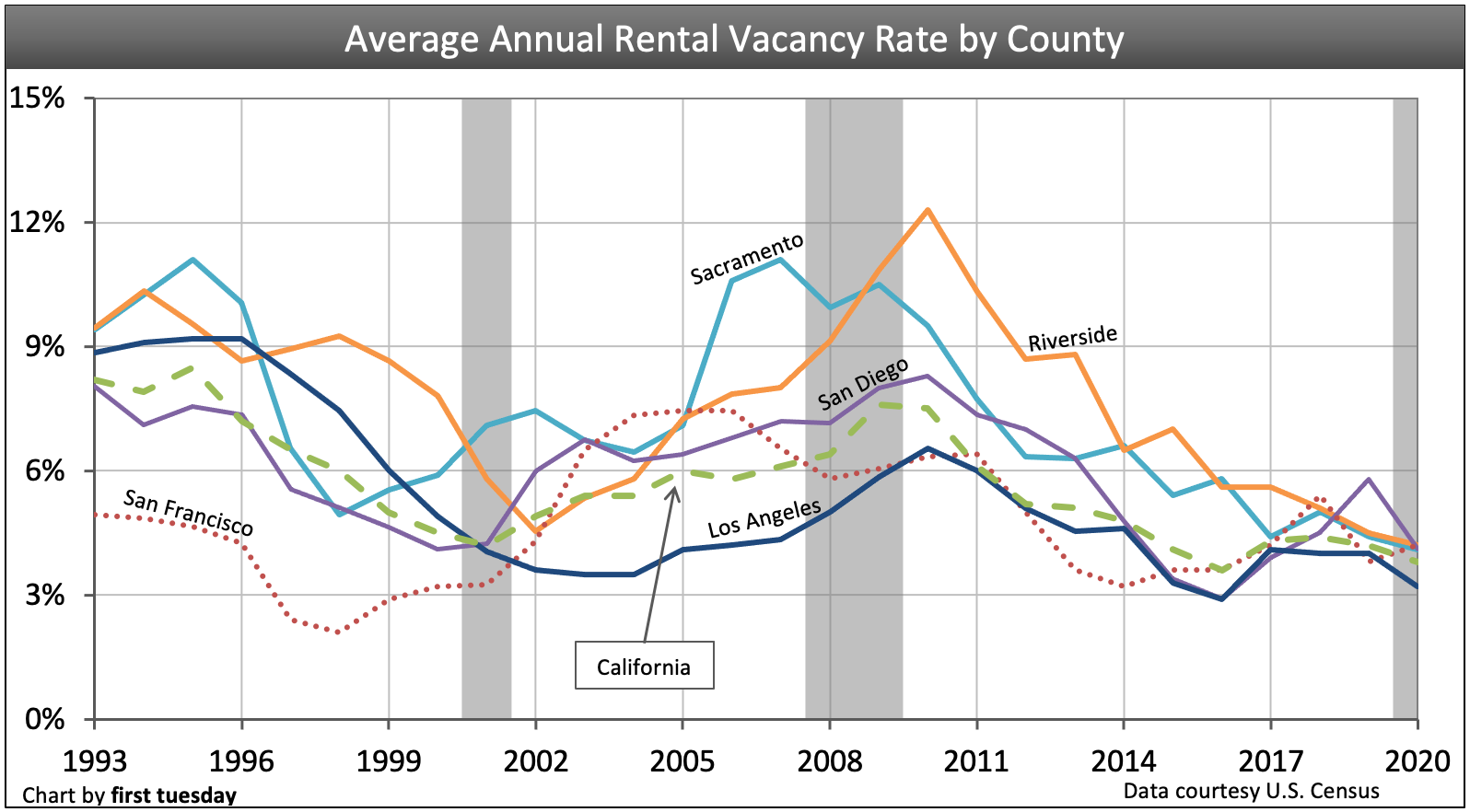Homeownership rates increased across the state in 2020. Riverside beat out Sacramento for the highest rate of homeownership, at over 65%. Los Angeles County remains the lowest at 48.5%. Statewide, the average homeownership rate reached 56.0%, its highest level since the 2008 recession decimated the housing market.
However, California’s homeownership rate is expected to reverse course in the next couple of years, having reached a peak for this housing cycle. As the foreclosure moratorium ends in 2021 and distressed sales flood the market, homebuyers will become more cautious, allowing home prices to decline. Homeownership will find greater support once jobs begin to return, likely around 2023.
The average rental vacancy rate declined to 3.8% in 2020, well below historic norms. Today’s low vacancy rate stems directly from 2020’s eviction moratorium, which has allowed tenants to remain in place due to the global pandemic, whether or not they have the ability to pay. The highest rental vacancy rate in 2020 was 4.2% in Riverside and San Francisco. The lowest was 3.2% in Los Angeles.
Rental vacancies will continue to linger below historic norms even after the eviction moratorium ends in 2021. That’s because California has experienced a housing shortage for years, with very little residential construction completions to add to the inventory. State-initiated legislative efforts to add to the housing stock have focused on encouraging more multi-family construction. However, social distancing and tightening lines of credit are holding builders back during today’s recession, which will combine to put downward pressure on multi-family starts in 2020-2023.
Post updated January 12, 2021. Original copy posted January 2013.
Chart 1

Chart update 01/12/21
Chart 2

Chart update 01/12/21
| 2020 homeownership rate | 2006 homeownership rate | |
| California | 56.0% | 59.3% |
| Los Angeles | 48.5% | 53.4% |
| Riverside / San Bernardino | 65.8% | 67.9% |
| Sacramento | 63.4% | 63.3% |
| San Diego | 58.3% | 60.4% |
| San Francisco | 53.4% | 59.4% |
Chart 3

Chart updated 01/12/21
| 2020 rental vacancy rate | 2006 rental vacancy rate | |
| California | 3.8% | 5.8% |
| Los Angeles | 3.2% | 4.2% |
| Riverside | 4.2% | 7.9% |
| Sacramento | 4.1% | 10.6% |
| San Diego | 4.1% | 6.8% |
| San Francisco | 4.2% | 7.5% |
Are rentals the future of California real estate? As homeownership and rental vacancy rates decline in counties across the state, a change in the housing market is on the horizon. The future will be determined by jobs, construction and foreclosure rates.
Chart 1 tracks the changing percentage of dwellings occupied by owners versus tenants in California. The sampling is indicative of our more populous counties.
Chart 2 tracks the homeownership rate in California and a sampling of its more populous counties.
Chart 3 tracks the rate of rental vacancies in California and a sampling of its more populous counties since 1993. Rental vacancies tend to rise in times of increased homeownership and excessive residential construction. Dark bars indicate periods of recession.
Future vacancy rates will be influenced by:
- the lifting of the eviction moratorium in 2021;
- regional foreclosures;
- regional job performance; and
- residential construction numbers.
Renting into the future
Increasingly, Californians are turning to rental property for their shelter.
This heavy reliance on rentals comes after the historic spike in homeownership during the Millennium Boom.
In the past, the thought of owning a home was driven by the noise of warped public policies and the distraction of ever more subsidies. The government intended to get tenants out of rentals and into homeownership.
Favorable personal attitudes about homeownership climbed for about 60 years. Then, in quick succession, we experienced a pricing bubble, a recession and a once-in-a-lifetime financial crisis.
Today, many households are still recovering from the financial chaos of the 2008 recession and lengthy recovery. The renter population has swelled, as fewer are able to buy after dealing with years of underemployment or unemployment. This has led to a supply issue, as more renters compete for multi-family units in desirable areas where zoning restricts builders from meeting demand. This has caused rents to rise much more quickly than income.
Recovering from foreclosure: to own or to rent
Many former California homeowners lost their property to foreclosure in the days following the 2008 recession. These owners suffered income loss due to unemployment. Some were simply unable to make payments when the time came to fully amortize a complex adjustable rate mortgage (ARM).
Financially unable to buy a replacement home to house their family, many homeowners moved into comparably-sized SFR rental property in the same school district. At first, the monthly rent was less than their previous mortgage payment. However, as rents have risen quickly in the past couple years, many renters are now looking to homeownership once again. But — their credit scores are often too damaged by the foreclosure (or short sale) to qualify for purchase-assist financing to buy a replacement home. Further, pouring high amounts of their income into rent disallows them from saving up for a down payment on a new home.
These renters-by-necessity are foreclosed-out homeowners and forced-out short sellers. They have no savings, damaged credit scores and an enduring emotional aversion to homeownership — at least in the foreseeable future.
So, for the next few years these families will live in rented homes. These and others have forfeited the tattered American Dream of homeownership for renting.
Related article:
Will foreclosed homeowners and short sellers return to homeownership?
This situation is now a full blown reality for homeowners across California. In 2020, California has one of the lowest homeownership rates in the nation at 56.0%.
Rentals as a percentage of all housing are highest within high-density metropolitan areas, especially in cities like San Francisco and Los Angeles. On the other hand, there are areas of traditionally high homeownership, like Riverside/San Bernardino and Sacramento. These regions have maintained a lifestyle focused on suburban housing, even through the difficult years of recession and today’s ongoing recovery. However, signs indicate that housing habits are changing even in these homeownership outposts.
Jobs’ impact on homeownership
Future homeownership rates depend upon the coming wave of first-time homebuyers. These homebuyers are typically aged 25-35. Often, they will purchase a low-tier or mid-tier SFR for their first homes.
Job loss, however, has changed the timing of homeownership in almost every region of California. First-time homebuyers are declaring themselves financially unable, or just plain unwilling, to purchase a home in spite of cyclically low prices and mortgage rates. The more realistic age of today’s typical first-time homebuyer is 30-40 years.
As jobs eventually return – expected to occur sustainably around 2023 – they arrive first and fastest in city centers. After running through any savings available during the reduced income years of the pandemic and 2020 recession, more of the newly employed will be renting than owning while they amass down payments.
Related articles:
Will first-time homebuyers save California’s homeownership rate?
Future rental construction will increase
An increase in rental activity will naturally be followed by an increase in rental construction. As vacancy rates linger below historic norms (generally near 5%, but averaging 3.8% in 2020) and rents rise beyond the rate of inflation, multi-family construction will return to keep rents and prices down.
Apartment and condo construction was at its lowest in 2009, and has increased very slightly most years since then. Despite the push for more housing, multi-family construction has fallen back in recent years. Going forward, multi-family construction will be influenced positively by legislative changes favoring low- and moderate-income, dense housing.
Related article:
Homeownership by county
Counties like Riverside were at the center of California’s housing boom in the early 2000s. During the Millennium Boom, homes were built and sold faster than was sustainable in the long term. Riverside’s homeownership rate jumped almost 6% in 2000-2005, pulling the state’s rate of homeownership up with it.
Those homeownership gains were illusory. From 2005 to 2014, Riverside’s rate of homeownership dropped significantly, seven percentage points below its level at the peak of the boom. However, it has also been one of the quickest to recover and as of 2020 is the metro area with the highest level of homeownership in the state.
With every statewide trend, of course, there are exceptions. San Francisco County experienced a less noticeable dent in homeownership during the recession, but has since gradually declined to near 53% in 2020. [See Chart 2]
San Francisco’s upside down homeownership trend is due to the severe lack of SFR construction and prevalence of high-tier properties in much of the Bay Area. Further, during the aftershocks of the 2008 recession, their population was less susceptible to foreclosure due to strong local employment in the information technology industry.
Many large southern coastal cities remain examples of past suburban sprawl and inefficient zoning. They have, however, begun to reorganize to a more sustainable, centralized model of higher density urban living.
Homebuyer demand shifts
Some who were burned by short sale or foreclosure will eventually return to the homeownership. They will be joined by first-time homebuyers who have put off homeownership. This return will occur when their jobs, savings, deleveraging, credit scores and confidence in the economy permits them to do so.
Meanwhile, bedroom cities in the suburbs continue to experience higher vacancy rates, though vacancies everywhere are down going into 2021, the result of the eviction and foreclosure moratoriums which have kept tenants and homeowners housed despite the inability of many to make housing payments.
In 2020, homebuyer demand outpaced supply, causing homebuyer competition and prices to soar, despite the recessionary environment. Fueling the rise were record-low interest rates, which boosted buyer purchasing power an equivalent amount.
Vacancies by county
Rental vacancies are driven by varying local demand. The key factors influencing vacancies are the local jobs situation and the local attitude toward SFR homeownership and renting, which change over time.
For instance, Sacramento and Riverside both experienced massive vacancies during 2006 into the early days of the 2008 Great Recession. Since then, these areas have seen rental vacancies drop dramatically. Still, while relatively low, vacancies remain highest in these suburban, inland communities.
The rise of rental property
Trends point to a continued increase in rental demand in upcoming years. While some regions, especially Riverside, will take a longer time to shift from the 1950’s standard of suburban SFR homeownership, rental property is poised to lead the real estate recovery. Even in counties with higher than average homeownership rates, rentals will emerge as significant profit centers for landlords and property managers.
Agents in urban areas may consider adding property manager to their title, as demand for this skill will undoubtedly rise throughout this decade. Also, following the local construction and job trends will help agents prepare for future demand in their communities.
SFR homeownership is nowhere near becoming obsolete. But its 30-year dominance is definitely a relic of the past.
Related article:















When renters “dominate” buy!!!!
When renters are at their “minimum” sell!!!!
Renters are the “left overs” or the “EXTREME FRUGAL”….
Decent article; just seems about 2 years out of date. These “forecasts” are and have been already happening for some time.
And as far as an “absence of willing homebuyers”, not in the Bay Area. I wish it were so… and my buyer clients were NOT continually being frustrated by multiple, over asking, and cash offers at these crazy levels. Folks are bidding up beyond current, intrinsic value in my opinion, but it is reality for now.
Even the trustee sales to investors are going on at near retail; quite a few times over current retail price!
Flippers have been making bank & quick; contrary to the assertion in this article on that point.
You Newletter’s have continued to you “right on” I find, what you state are the “coming Trends” are following that course in my Marketing area, I am in Aguanga/Anza, Marketing in that area, since 1979, This is the worst market, I have seen in this area, even worst than the 1991-99, era, Now, with Rentals down, and still many
foreclosures, that were “held back”l last year. We are seeing them either, being sold in “bundles”at auctions,
or finally coming on the market. Our inventory, currently is low, and a “false” increase in prices, reflect the
demand, However, many properties, are not in “” Lender financing” condition, so they are being offered in the $70,000 price range, where the homes in decent condition, are in the $124,000 and up, however, still in
short sale position” We are definitely not out of the woods yet!
Heather